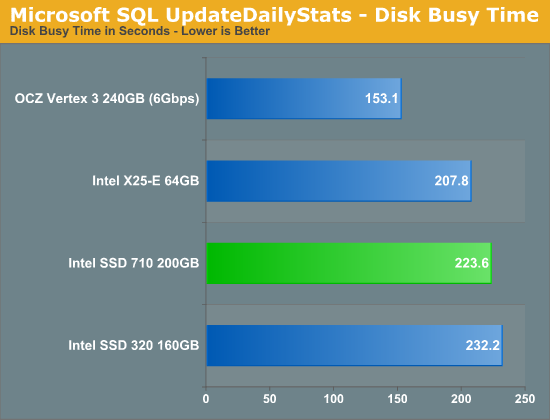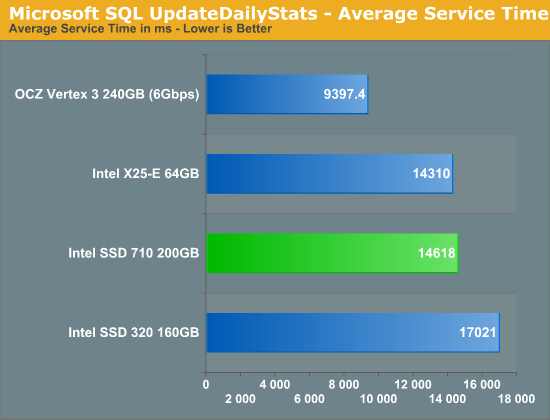The Intel SSD 710 (200GB) Review
by Anand Lal Shimpi on September 30, 2011 8:53 PM EST- Posted in
- Storage
- SSDs
- Intel
- Intel SSD 710
Enterprise Storage Bench - Microsoft SQL UpdateDailyStats
Our next two tests are taken from our own internal infrastructure. We do a lot of statistics tracking at AnandTech - we record traffic data to all articles as well as aggregate traffic for the entire site (including forums) on a daily basis. We also keep track of a running total of traffic for the month. Our first benchmark is a trace of the MS SQL process that does all of the daily and monthly stats processing for the site. We run this process once a day as it puts a fairly high load on our DB server. Then again, we don't have a beefy SSD array in there yet :)
The UpdateDailyStats procedure is mostly reads (3:1 ratio of GB reads to writes) with 431K read operations and 179K write ops. Average queue depth is 4.2 and only 34% of all IOs are issued at a queue depth of 1. The transfer size breakdown is as follows:
| AnandTech Enterprise Storage Bench MS SQL UpdateDaily Stats IO Breakdown | ||||
| IO Size | % of Total | |||
| 8KB | 21% | |||
| 64KB | 35% | |||
| 128KB | 35% | |||

In the first of our two SQL tests the 710 and X25-E are far closer than they were in the Swingbench results. Although the 710 uses MLC-HET NAND, it delivers 93% of the performance of the X25-E. The SF-2281 based Vertex 3 pulls ahead, but this is obviously a consumer drive and not something I'd expect 710 customers to be cross shopping. An enterprise version of the Vertex 3 with a proven track record could be a very interesting option however.


Despite relatively close average data rates, average service time is significantly improved over the desktop 320. Furthermore the 710 cranks through IOs at nearly the same latency as Intel's X25-E. Under heavy load, the X25-E and SSD 710 are virtually indestinguishable. Once again SandForce shows its strengths quite well here.










68 Comments
View All Comments
Juri_SSD - Saturday, October 1, 2011 - link
Anand, I have read your previous articles and there where all somehow good. But this one misses one important thing and therefore there are many comparisons, that aren´t correct. When I saw the video, I just thought what is wrong with you.First of all: How dare you to compare a 50nm Flash-SSD with a 25 nm Flash-SSD and say that there is only a saving of cost because of use the cheaper MLC instead of SLC? That is so wrong! You can just shrink the 50nm SLC to 35nm SLC and you have lowered the price to half, then you go on and shrink it to 25nm and you have a further reduction in price and end up at a 1/4 price of an 50nm SLC-NAND just by shrinking the Cells.
Secondly: How dare you compare a 50nm FLASH-SSD with a 25nm Flash-SSD and then say that you have now more than 64 GB just because Intel wisely uses MLC? Hello? What about shrinking again? Your video is so wrong… 64 GB 50nm SLC -> shrinking -> 128 GB 34nm SLC -> shrinking -> 256 GB 25 nm SLC!
What do we have? Intel could make a 256 GB SLC-drive just by shrinking. Instead of pointing this out, you told the people how “good” Intel does his job by sorting out good MLC-NAND to compete against an very very very old, really old SSD. The only winner on this “good” job is Intel itself. The enterprise-consumer waits for a competitor who actually shrinks the SLC-Nand to 25nm.
Then again: You compare GB/Dollar. That is nice. And then you do a long speech about servers that really need all this p/e-cycles. But, if the servers really need all this p/e-cycles, why do you not compare p/e-cycles/Dollar? Perhaps, because the new 710-SSD really sucks on that comparison, also against an really old SLC-SSD like the Intel X25-E?
Then again, you can say: “All right, you are right Juri, but there are no 34nm SLC-Flash” Ups, this is also untrue, there are 34nm SLC-Flash-drives, so why you don’t compare GB/Dollar with these drives? You don’t know what I mean? How about Intel SSD 311? If you compare that 20 GB SLC 34nm NAnd-Flash drive, you see that the price of an 710-SSD you could easily make with a simple shrinking of SLC-NAND, just like I told in the first point.
I am really disappointed by your review.
PS: If you think my english is bad, you can try reading in german: http://hardware-infos.com/news.php?news=3946
lemonadesoda - Saturday, October 1, 2011 - link
I disagree with the statement that the SSD market is a race to the bottom. I think this is a lazy catchphrase that demonstrates a company's unwillingness to innovate. It is like saying the CPU or GPU or TFT or mobile handset business is a race to the bottom. Clearly, this is not true!There is plenty of room for Intel to innovate, differentiate, and gain margin on consumer SSD.
What SSD "technologies" would be interesting for the consumer? Encryption; Response-to-theft management; Wear leveling; SMART 2; Thunderbolt, etc. that would allow Intel to lead and to charge a premium on the consumer product.
Intel owns the Light Peak/Thunderbolt technology. Intel should get Thunderbolt onto it's PC chipset and get a range of SSDs onto Thunderbolt. Why are we using (e)SATA as a slow intermediary layering protocol when thunderbolt could do this and do it better? With Intel thunderbolt on the Intel mainboard, and compatible Intel SSD, we would no longer find PCIe based SSD or RAID0 SATA interesting. Intel could claim the enthusiast (not just enterprise) market in one swoop. And enthusiast drives consumer branding and perception.
There's still a lot of room for Intel in the SSD market. Or perhaps the current team has run out of ideas and motivation?
Friendly0Fire - Saturday, October 1, 2011 - link
Actually, no, there's a point you're missing. At the moment the biggest barrier to adoption with SSDs is... price. Specifically cost/GB. CPUs, GPUs and mobile handsets can be had for all price ranges, thus you see a good amount of spread between low and high end. CPUs and GPUs also have the advantage of being bundled in prefab computers, while mobiles get heavy price cuts through mobile plans.SSDs, however, are still restricted to a niche market, only seen as an optional component on high-end computers or bought directly as a separate piece. Sadly, most people still consider "performance" to be summarized by how many GHz and GBs your computer has. SSDs can improve performance tremendously, but good luck explaining what IOPS or bandwidth mean. Until prices are closer to that of magnetic drives, most people won't even be interested in learning about them.
So yeah, for the time being SSDs are a race to the bottom in the customer market. Performance is what I'd call good enough for 99.95% of computer users, even when you consider 3Gbps last-generation drives. What matters now is price drops.
EddyKilowatt - Tuesday, October 4, 2011 - link
I agree that price is the #1 barrier in the minds of potential adopters, but right after that comes reliability, and I think this looms equally large once people get used to the price and understand the performance benefit.Many are waiting for all the myriad 'issues' to get sorted out... until they do, it won't truly be a price-driven commodity market. And until they do, Intel can offer added value -- if they're careful about reliability themselves -- that justifies the price premium they'd like to charge.
Perhaps SSDs aren't as architecture and innovation driven as CPUs, but there's way more to them than just bulk memory mass produced at sweatshop wages.
AnnonymousCoward - Saturday, October 1, 2011 - link
Synthetic hard drive comparisons are not reality.Luke212 - Sunday, October 2, 2011 - link
Anand, Businesses do not run SSDs as single drives or raid 0. Failures being 1-2% it is too disruptive to business (unless they are read only). Can you consider testing these drives in Raid 1, which is how they are used in real life?Iketh - Monday, October 17, 2011 - link
That would depend on the raid controller's performance, not the drive.ClagMaster - Sunday, October 2, 2011 - link
"It wouldn't be untrue to say that Intel accomplished its mission."Means after the reader deciphers this ...
"It would be true to say that Intel accomplished its mission."
Do not do this. I have skinned engineers alive for making this kind of double-negative grammatical error in their reports I often have to shovel through. I hate teaching engineers English. Do make the change.
Your comments about Intel's leadership in the consumer SSD and enterprise SSD development pretty much hit the nail on the head.
Intel essentially created the consumer market for these SSDs. Not OCZ, Marvel and Sandforce. They are the dogs eating the crumbs.
Intel does some serious prototype testing before these products hit the shelves. Far more than its competitors.
This is another well balanced, high quality SSD.
ClagMaster - Sunday, October 2, 2011 - link
When I mean well balanced, I mean this is not a SSD for the obscessive-compulsive speed free with money to burn.This SSD is a good balance of cost, performance and reliability for the enterprise space. Its optimized for cost and reliability which limits performance somewhat.
Althoug slow compared to a Vertex 3, the SSD710 would still provide fine performance for consumer PC's as a boot drive.
AnnonymousCoward - Sunday, October 2, 2011 - link
"slow compared to a Vertex 3, the SSD710 would still provide fine performance"Wouldn't it be nice to have quantified results??? Like Windows boot time, time to launch programs, and time to open big files.
Synthetic benchmarks are both inaccurate, and provide no relative information. And synthetic benchmarks have been known to be inaccurate, on Anand's own site!
____________
http://tinyurl.com/yamfwmg
In IOPS, RAID0 was 20-38% faster; then the loading *time* comparison had RAID0 giving equal and slightly worse performance! Anand concluded, "Bottom line: RAID-0 arrays will win you just about any benchmark, but they'll deliver virtually nothing more than that for real world desktop performance."
____________
Anand stays stubborn to his flawed SSD performance test methods. If anyone is deciding between a Vertex 3 or an Intel, the single most important data would be the quantified time differences in doing different operation. You'll have to go to another website to find that out.